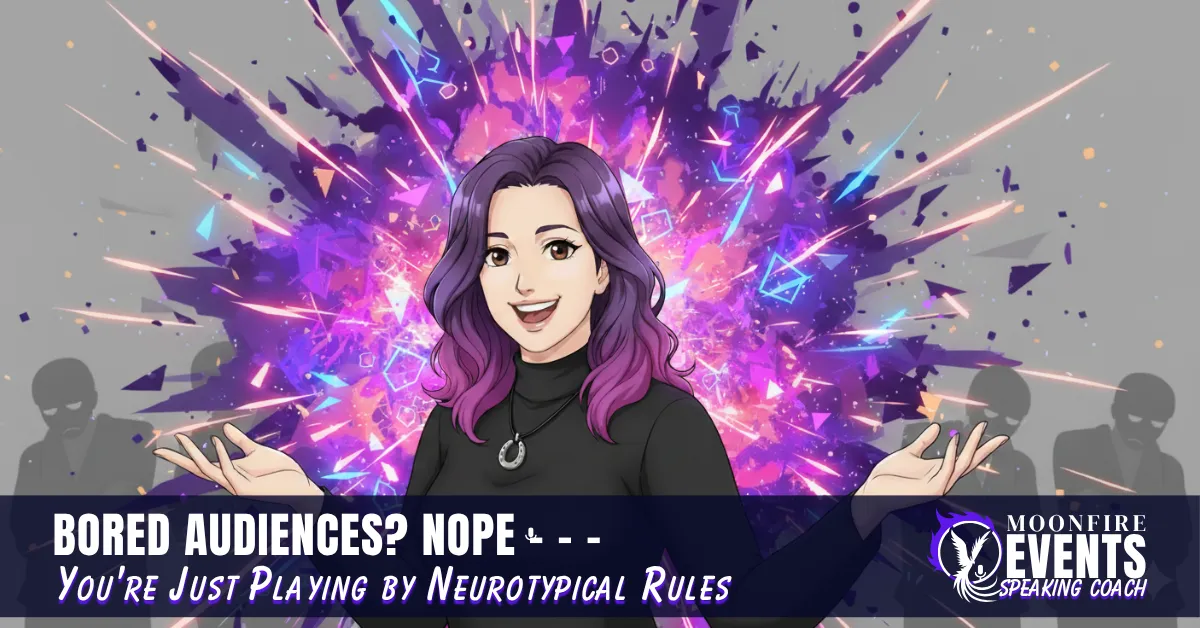
Bored Audiences? Nope - You're Just Playing by Neurotypical Rules
Bored Audiences? Nope - You're Just Playing by Neurotypical Rules
The Dead Room Moment
You're three slides in. You can see it - the head tilts, the glazed stares, someone definitely checking their phone under the table. Your brain starts that familiar spiral: I'm losing them. I need to slow down. Be clearer. Be calmer. More professional.
So you do. You pull back. You smooth out your delivery. You flatten your voice into that "credible expert" tone.
And the room gets even deader.
The Lie That's Keeping You Small
"Your audience is bored because you're too much." That's the lie we've been fed.
Here's the outlaw truth: your audience isn't bored because you're too much. They're bored because you've been told to play small, tone it down, and package your brilliance into polite, beige delivery.
Neurodivergent women are some of the most magnetic speakers out there - when we stop swallowing our energy to fit neurotypical rules. Audiences don't need you muted. They need you unleashed.
The "Professional" Mask Is Suffocating Everyone
ND women are constantly told:
Don't move too much.
Don't talk too fast.
Don't show too much emotion.
Don't go on tangents.
Don't interrupt yourself with stories.
Translation? Be smaller. Be contained. Be less.
But here's what no one tells you: that mask isn't just suffocating you. It's boring your audience senseless.
When you flatten your natural intensity to fit some corporate ideal of "polished," you strip out the very thing that makes people lean in: authentic energy. The spark. The aliveness. The thing that makes someone stop multitasking and actually pay attention.
You're not "too much." You're being contained to death. And your audience can feel it.
What Happens When You Swallow Your Energy
Trying to be "professional" often means trying to be contained. Controlled. Predictable. Safe.
And here's exactly what that costs you:
Glazed faces. People disengage because they're not feeling anything from you. They might be hearing your words, but nothing's landing. No spark. No resonance. Just information floating in dead air.
Low interaction. You get polite nods, not sparks of conversation. Maybe a few "great presentation!" comments that feel hollow. No one's sliding into your DMs. No one's asking follow-up questions. No one's moved.
Complete burnout. You leave drained, exhausted, empty - because you spent 45 minutes performing a version of yourself instead of showing up as yourself. Masking takes energy. Massive amounts of it. And for what? A room full of people who looked bored anyway?
Here's the truth most speaking coaches won't tell you: Audiences don't remember facts. They remember energy. They remember how you made them feel. They remember the moment you got excited about something and they could feel it radiate off you.
When you cut off your natural energy to appear "professional," you're not protecting your credibility. You're strangling your magnetism.
What You Do Naturally That Audiences Actually Crave
Let's talk about what happens in your neurodivergent brain when you're speaking - the things you've been told to suppress:
Associative thinking creates unexpected connections. Your brain makes leaps. You see patterns between seemingly unrelated things. You connect concepts in ways that make people go "holy shit, I never thought of it that way." That's not distraction. That's insight.
Hyperfocus creates depth that feels revelatory. When you get into something, you GO there. You dive deep. You notice details others miss. You bring a level of specificity and passion that makes people feel like they're getting the real stuff, not surface-level platitudes.
Emotional honesty creates trust at lightning speed. You feel things intensely and you show it. When you're excited, you're EXCITED. When something matters to you, everyone in the room knows it. That vulnerability? That realness? That's what creates connection faster than any "credibility-building" technique ever could.
Your tangents are actually thematic gold. What you call "going off track," your audience experiences as texture, context, and the humanity that makes your content memorable.
These aren't bugs. They're features. They're the exact qualities that make people stop scrolling, put down their phones, and actually engage.
But you've been taught to suppress every single one of them.
The Three Moves That Wake Everyone Up
If you've been told your delivery is "too intense," "too fast," or "too emotional" - congratulations. Those exact qualities are the ones that keep audiences awake.
Here are three rebel moves to stop boring your audience and start igniting them:
1. Story Sparks (Every 5–7 Minutes)
ND brains thrive on story. So does your audience's attention span. But we're not talking about long-winded case studies. We're talking micro-stories that create a spark and get out.
Three types to rotate:
Personal micro-story (30 seconds max): "I was on a call last Tuesday and realized I'd been explaining my pricing for ten minutes. The prospect interrupted me and said, 'I don't need convincing. I need the link.' That's when I realized..."
Client example with sensory detail: "Sarah came to me with a webinar that was perfectly structured, beautifully designed, and putting people to sleep. We didn't change the content. We changed one thing: she started letting herself get interrupted by her own thoughts out loud. Her conversion rate tripled."
"What if" hypothetical that activates imagination: "What if the moments you think you're 'losing the thread' are actually the moments where you're most interesting? What if your audience is leaning in, not checking out?"
Stories create pattern interrupts. They reset attention. They make abstract concepts concrete. Use them liberally.
2. Pattern Callouts (Name What You Notice)
ND women are natural pattern recognizers. You see micro-expressions. You notice energy shifts. You track engagement in real time.
Stop hiding that superpower. Use it.
Steal these phrases:
"I'm noticing energy shifted when I said X - what landed there?"
"Three of you just leaned forward. Hold that thought, I'm coming back to it."
"The chat just exploded. Tell me what I just activated."
"I see heads nodding. Someone tell me what that's connecting to for you."
"Okay, I felt the room go quiet. What just happened?"
"I'm watching faces light up right now. What are you thinking?"
When you name what you notice, two things happen: You demonstrate that you're actually present with your audience (not just delivering pre-programmed content), and you give people permission to engage because you've acknowledged they're having a real-time experience.
This isn't a parlor trick. This is leveraging your natural attunement as a feature, not something to hide.
3. Micro-Interactions (Keep Energy Flowing)
One-word chat prompts, emoji drops, quick polls - these keep energy moving without derailing your delivery.
When to use each:
Polls when you want quick data or to prove a point: "How many of you have been told you're 'too much' in a professional setting? A lot? A few? Never?" The results validate your audience's experience and build instant rapport.
Chat prompts when you want texture and nuance: "Drop one word in the chat: what does 'too much' feel like in your body?" You'll get a cascade of responses that creates collective energy.
Emoji drops when you want a vibe check without stopping flow: "If this is landing, drop a 🔥 in the chat." Low barrier, high engagement, keeps momentum.
And here's what to do when no one responds (the ND speaker's nightmare): Don't panic. Don't apologize. Don't make it awkward. Simply say: "I'll take the silence as deep processing. I'll keep going." Then move forward like nothing happened. Often, engagement picks up once people see you're not fazed.
The goal isn't to perform engagement. It's to create space for it without your energy deflating when it doesn't happen immediately.
But What If I'm Actually Too Much?
Let's address the fear underneath all of this: What if you're not being authentic - what if you're actually being chaotic? What if your intensity isn't magnetic, it's overwhelming?
Fair question. Here's the nuance:
Authentically intense looks like: passion that invites people in, energy that ebbs and flows naturally, focus that's contagious even when it's deep.
Trauma-response frantic looks like: energy that feels manic or desperate, talking AT people instead of WITH them, intensity that leaves no space for others to process or respond.
The difference? Regulation and attunement.
Unregulated energy can overwhelm. If you're bouncing off the walls because you're anxious, if you're speeding through content because you're terrified of silence, if your intensity is coming from a need to prove yourself - that's different than natural enthusiasm.
Here's your self-check:
Ask yourself: Am I adjusting to the room's energy, or am I performing smallness?
If you're noticing the room and responding to it (even if imperfectly) → you're attuned. Keep going.
If you're bulldozing through because stopping feels too vulnerable → pause. Breathe. Reconnect.
Authentic intensity creates space. It invites. It notices.
Frantic energy fills all the space because it's afraid of what might happen in the silence.
You'll know the difference by how you feel afterward. Authentic shows up energized (even if tired). Frantic collapses.
And here's the thing: even if you occasionally tip into "too much," that's still better than playing small. You can always dial back. But you can't dial up from muted. Start with full volume and adjust from there.
When You Stop Masking, Everything Shifts
Let me tell you about Maya.
She used to rehearse her presentations until they were airtight. Every word scripted. Every transition smooth. Every tangent cut. She looked polished. She sounded credible. And her audience engagement scores were hovering around 4.2 out of 10.
Then she stopped rehearsing. She started using bullet points instead of scripts. She let herself interrupt her own points with examples. She started saying things like, "Oh wait, this reminds me of - " and going there. She let her voice get excited. She laughed at her own observations.
Her engagement scores jumped to 8.9. Same content. Same expertise. Different energy.
One attendee told her: "This is the first webinar I've attended in six months where I didn't have another tab open."
That's what happens when you stop performing containment and start showing up.
Your Outlaw Permission Slip
Here's what you need to hear:
You don't need to "calm down" or "slow down" to be credible. You don't need to wear the corporate mask to be powerful. You don't need to sand down your edges to be professional.
Rebel moves that actually work:
Get animated. Let your voice rise and fall with your actual emotion. Interrupt yourself with a story when it bubbles up. Laugh at your own joke. Go on a tangent and then say, "Okay, circling back." Speed up when you're excited. Slow down when something lands heavy.
That's not "unprofessional." That's alive.
And aliveness is magnetic.
Your "too muchness" isn't a liability. It's the spark your audience has been waiting for.
The Rule We're Burning
The old rule: Be calm. Be measured. Be contained. Be palatable.
The new rule: Be present. Be real. Be you.
Audiences don't want muted, palatable presenters who sound like every other "expert" they've heard. They want presence that makes them feel something. They want energy that wakes them up. They want someone who gives a damn enough to let it show.
So if your audience looks bored, don't shrink yourself further. Don't add more polish. Don't rehearse the life out of your content.
Do the opposite.
Let your natural intensity out. Let yourself be interesting. Let your brain do what it does best: make unexpected connections, dive deep into what matters, and bring the kind of aliveness that reminds people why they showed up in the first place.
Because your "too muchness"?
That's not your problem.
That's your signature.
Ready to design presentations that feel authentic, alive, and actually convert? Let's talk about what's possible when you stop masking and start magnetizing.
Claudine Land The Virtual Event Whisperer| Founder, Moonfire Events
Where "too much" becomes your greatest business asset
Core Questions
Q: Why do audiences look bored during presentations?
A: Because the speaker is flattening their natural energy to sound “professional.” Audiences don’t remember facts - they remember energy. Muted delivery kills engagement.
Q: Are ND women really “too much” when presenting?
A: No. ND traits like intensity, hyperfocus, tangents, and emotional honesty are what keep audiences hooked. They’re engagement assets, not liabilities.
Q: What actually makes presentations engaging?
A: Presence that feels alive - micro-stories, pattern callouts, and interactive moments. Audiences want to feel something, not just hear information.
Q: How can ADHD or autistic presenters keep audiences engaged?
A: Use ND-friendly tactics:
Story sparks every 5–7 minutes.
Call out patterns you notice in the room.
Quick interactions like polls, emoji drops, or one-word prompts.
Q: What’s the cost of masking to appear “professional”?
A: Masking drains energy, creates flat delivery, and leaves you burned out. It doesn’t build credibility - it strangles magnetism.
Q: Is it better to be “too much” or “too little” on stage?
A: “Too much” is always better. Authentic intensity can be adjusted in real time, but you can’t dial up from muted. Start with full energy and refine from there.



